


examination before cataract surgery
examination before cataract surgeryis the leading cause of blindness worldwide. The World Health Organization (WHO) reports that an estimated 19.34 million people globally are blind due to age-related cataracts, accounting for 43% of all cases of blindness.1With population growth and increased life expectancy, the number of blind individuals and the rate of cataract‑related blindness are expected to continue rising worldwide. Common symptoms of cataracts include blurred vision, glare, and dimming of colors. Causes of cataracts include aging of the lens and other eye diseases. At present, the preferred treatment is minimally invasive phacoemulsification surgery to remove the cataract, followed by implantation of an intraocular lens (either monofocal or multifocal). Hospitalization is generally not required, and recurrence does not occur after surgery.
1Source: World Health Organization
What is Cataract?
A cataract is a change in the protein of the lens in the eye that gradually degrades, hardens, and becomes opaque, so that vision is blurred as if covered by a foggy lens. The disease is likely to occur in one or both eyes, which, however, do not spread or infect each other. The condition varies depending on the location and degree of clouding of the lens. Vision loss also varies from person to person and can be severe enough to cause blindness.

Symptoms of Cataract
Early-stage cataracts do not show any obvious symptoms, but as the condition becomes more severe the following symptoms may occur:

Blurred vision

Glare appears

Landscape colours
become dull

Double or multiple
vision in one eye

Refractive errors get worse
(myopia, astigmatism)
Causes of Cataract
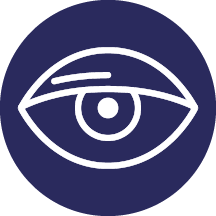
Aging of the lens
with aging
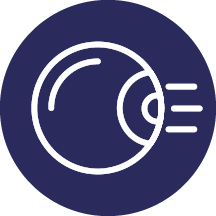
External Trauma
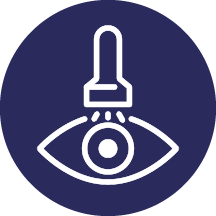
Excessive ultraviolet- /
infrared-light exposure
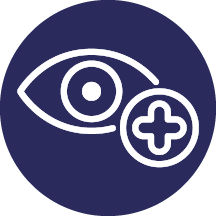
Metabolic diseases
(e.g. diabetes)

Drug-induced
(e.g. prolonged use of steroids)

Other eye illnesses
(e.g. high myopia)

Congenital or genetic factors
Phacoemulsification
Cataract removal surgery

Currently, there is no medication that can effectively prevent or treat cataracts. Cataract surgery is the only recognized effective method of management.
Minimally invasive phacoemulsification cataract surgery is currently the preferred treatment method. The procedure requires only local anesthesia. The main surgical technique involves using ultrasound to break the cataract into small fragments, which are then removed before implanting an artificial intraocular lens. After surgery, the posterior capsule of the eye becomes clear again, allowing light to refocus on the retina, thereby restoring vision and reducing refractive errors. The surgery is short in duration, patients can usually go home the same day, and recovery is fast.
Local anaesthesia
Go home on the same day
of the surgery
Surgery can be
as short as 10-20 minutes
Minimally invasive
surgery has small wounds
Reduce refractive errors
(myopia, hyperopia, presbyopia and astigmatism)
Low risk of wound
infection and complications
Local anaesthesia
Go home on the same of the surgery
Surgery takes only 10-20 minutes
Minimally invasive
Reduce refractive errors (myopia, hyperopia, presbyopia, astigmatism)
Low risk of wound infection and complications
Procedure of ultrasound cataract surgery

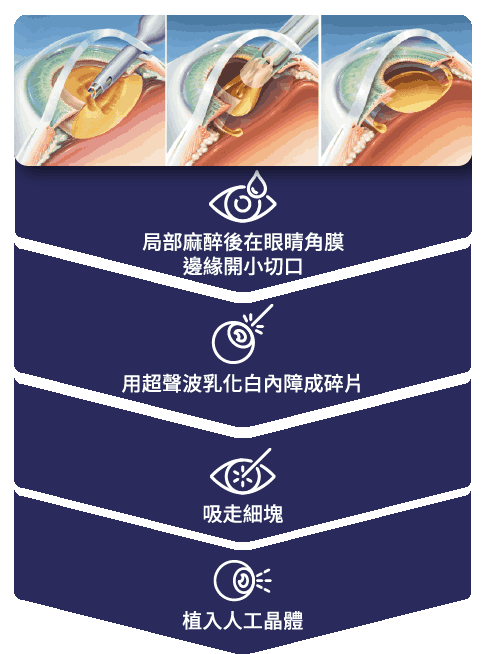
Types of Intraocular Lens (IOL):
| Monofocal Lens | Multifocal Lens (Trifocal) | Multifocal Lens (EDOF) | |
|
|
Good vision at one distance | Good vision at multiple distances | Good vision at multiple distances + Extended depth of field |
|
|
Excellent, delivers good vision at far, medium or near distances | Excellent, delivers good vision at far, medium or near distances | Excellent, delivers good vision at far, medium and near distances; continuous vision at a range of distances; less halos and glare |
|
|
Optional | Optional | Optional |
|
|
Inability to focus on near and far vision at the same time | Inappropriate for people with high vision requirements at night, such as night-shift drivers | Absence of trifocal features for near distance |
|
|
|
|
|

Preparing for Cataract Surgery

- Comprehensive eye examination, including vision exam, corneal exam, etc.
- Choose the right IOL according to your doctor's recommendation
- Please follow your doctor's advice when prescribing medication for pre-operative use if necessary
- Please inform your doctor in advance if you are taking medication for a long period of time
- It is advisable to arrange for family or friends to pick up after the surgery
- You can eat and drink as usual before the operation


Postoperative Care

- Follow your doctor's instructions on the use of medication to prevent infection and reduce inflammatory response
- For 1 to 2 weeks after surgery:
- Do not rub or scratch your eyes at any time
- Do not bend over to wash your hair or shower to prevent splashing water into your eyes
- Avoid strenuous exercise, running and jumping to prevent increased intraocular pressure which may affect wound healing
- During the first week of recovery, it is recommended to wear an eye shield when sleeping to prevent unintentional contact with the wound
- Follow up on your doctor's advice to ensure you are well after surgery

Cataract Surgeries Programme
(Cataract Surgery Subsidy Scheme)
Our ophthalmology specialists are among the designated doctors of the Hospital Authority’sCataract Surgeries Programme.
Eligible patients are welcome to receive cataract treatment at our center.
Details of the Programme can be found here.
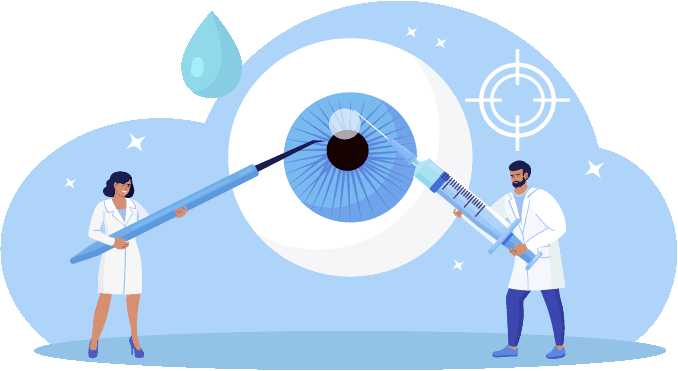
Cataract FAQ
Should I wait until the cataract get mature?
Mature cataract refers to a condition in which the lens of the eye becomes increasingly opaque, turning a milky white or amber color. The opacity extends to the edges of the lens and has a marked impact on vision. The more advanced the cataract, the greater the difficulty of treatment. Therefore, it is recommended not to wait until the cataract becomes fully mature before undergoing surgery.
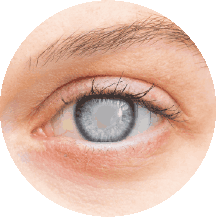


Can cataract surgery alleviate other eye problems?
It can reduce refractive errors (myopia, hyperopia, presbyopia, astigmatism).
Will cataracts recur after surgery?
No, because once the intraocular lens is implanted, it can be used for life without replacement unless it cannot adapt or cope with daily needs.
Does cataract surgery need to be done in hospital?
No, cataract surgery is a minimally invasive procedure. Although patients remain awake during the treatment, most do not feel pain and can return home on the same day.
What precautions should be taken after cataract surgery?
- To prevent increasing intraocular pressure and affecting wound healing, please avoid bending/leaning over, sneezing, driving on the second day after surgery, and engaging in strenuous exercise such as cycling, jogging, swimming or aerobic exercise within 1 to 2 weeks. Or consult your doctor if the situation permits.
- Do not rub or scratch your eyes at any time
- It is recommended to sleep on your back and wear an eye mask to prevent unintentional contact with your eyes while sleeping and reduce the risk of infection and irritation after surgery.
- Do not wear makeup, dye or have your hair done for 1 to 2 weeks.
Can I use mobile phones, watch TV, computers and other electronic devices after cataract surgery?
Under normal circumstances, you can watch TV, computer, and use mobile phones one day after cataract surgery. However, due to the brightness of the electronic screen, it may cause some discomfort to the eyes, but it will get better over time.
When can I take a shower after cataract surgery?
You can shower or bathe 24 hours after surgery. But don't let water or body wash get into your eyes. Close your eyes when showering to prevent sewage from splashing into your eyes.
Will I feel tired and uncomfortable after cataract surgery?
There may be a halo in the visual field for the first day or two after cataract surgery, especially after a multifocal lens is implanted, but this will gradually improve. The eyes may also experience irritation and foreign body sensation. Moreover, on the day after the operation and the next day, you may feel tired and you can sleep more. This is the body's way of repairing itself.
Can I go for a walk after cataract surgery?
It is recommended to avoid any exercise for at least one week after surgery. Any discomfort and tenderness caused by surgery will go away within a few days, and you can start with some light to moderate exercise, such as walking or some simple stretches at home.
How many days of rest do I need after cataract surgery?
Everyone’s recovery time is different, but many patients have clear vision within 24 hours of surgery. One to three days of rest is recommended to ensure adequate time for rest, and most patients can return to normal activities within a few days.

